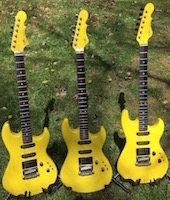HI,
I'm wanting to order a G&L USA Legacy, but am in the UK and have never tried the Modern Classic neck profile.
I know that the G&L website explains these differences, but I would be interested in hearing the views based on G&L players and their real world descriptions?
Also, is there much difference between the 9.5" and 12" neck radius? I've played 12" and 15" but am not so familiar with 9.5". Again, I know the website explains these differences, but I'd like to hear real worldl views from yourselves please.
Thanks!
9.5" v 12" neck radius / Modern classic v Classic C neck
-
SCAD
- Posts: 22
- Joined: Fri Mar 02, 2018 9:03 am
-
Danley

- Posts: 711
- Joined: Wed Aug 12, 2015 9:23 pm
- Location: Orange County, California Republic
Re: 9.5" v 12" neck radius / Modern classic v Classic C neck
I can only comment on radius; 9.5" and 12" are not a world apart. Then again I own guitars with 7" radii as well as 16"/compound and get along with each of them. If you care about having your action as low as possible, flatter is always better; not just because of bends "fretting out," but overall action can be adjusted lower when the strings conform to a flatter surface. Then again if you're one of those who is fine with action at 2-3mm or so in any case, a flatter radius is unlikely to make a difference in your playing.
In theory a rounder/smaller radius allows one's fingers to conform to the shape of barre chords etc. with greater ease; but in practice I've never noticed this. Things like fret size make a much bigger difference, IMO. I've never thought a chord was more or less challenging to make due to the radius of a fretboard.
In theory a rounder/smaller radius allows one's fingers to conform to the shape of barre chords etc. with greater ease; but in practice I've never noticed this. Things like fret size make a much bigger difference, IMO. I've never thought a chord was more or less challenging to make due to the radius of a fretboard.
-
DanDoulogos

- Posts: 716
- Joined: Tue Dec 20, 2016 9:08 am
- Location: Canada
Re: 9.5" v 12" neck radius / Modern classic v Classic C neck
I think Danley gave a great answer.
Picture an isosceles triangle with the long sides each measuring 9.5 inches, and the short side measuring 1.7 inches (the width of a fretboard). Now imagine that placed inside a circle where the radius was 9.5 inches, such that the point on the triangle where the two 9.5 inch sides meet, is at the center of the circle, such that the other side cuts a 1.7 inch chord through the circumference of the circle. The distance in inches between the center of the chord and the arc above it is only 0.00956 inches. That represents the height difference from the edge of the fretboard to the middle. If you do the same with a 24 inch circle, using an isosceles triangle with two 12" sides, etc. The chord that is cut by the 1.7 side of the triangle is sits even closer to the arc (0.00753 inches).
Edit: Corrected my math here...)
That is a very small difference (.002 inches) we're talking two thousandths of an inch difference in the height of the arc over the fretboard measured from the middle of the fretboard to either edge. I don't care how soft anyone's touch is, most of us won't notice that subtle a difference in most of what we play. Mathematically speaking, even a difference of 2/1000 of an inch in the height of the arc should allow us to to solo better on a 12" radius fret board and chord better on a 9.5" radius fret board. But I think for most of us the distinction will remain mathematical rather than practical.
Depending on tool tolerances (remember we're talking about a 2/1000" difference in height over 0.85 inches (the distance from the edge of the fretboard to the middle of the fretboard), the difference between neck radius may be more of a mathematical target than an actual measurement. CNC machine tolerances are pretty tight, but as their bits are used, they wear down, and tolerances can slip. Fretboards cut when the bits were knew will have a tighter tolerance than the last fretboards cut prior to changing out the bits. That means that depending on the quality controls in the shop where the fretboard is carved, a 9.5" radius could be closer to a 12" than you might expect.
If you find two guitars with identical necks - the only difference being the radius - I don't think many players would tell the difference blindfolded. Likewise if you find two guitars with identical necks and the same radius - but told people one was a 9.5 and the other a 12 - you'd probably get people saying they could feel a difference - not knowing that the difference they feel either represents their own subjective impressions, or maybe even a difference in tolerances when the necks were carved.
Bottom line is, You probably won't notice much of a difference.
Picture an isosceles triangle with the long sides each measuring 9.5 inches, and the short side measuring 1.7 inches (the width of a fretboard). Now imagine that placed inside a circle where the radius was 9.5 inches, such that the point on the triangle where the two 9.5 inch sides meet, is at the center of the circle, such that the other side cuts a 1.7 inch chord through the circumference of the circle. The distance in inches between the center of the chord and the arc above it is only 0.00956 inches. That represents the height difference from the edge of the fretboard to the middle. If you do the same with a 24 inch circle, using an isosceles triangle with two 12" sides, etc. The chord that is cut by the 1.7 side of the triangle is sits even closer to the arc (0.00753 inches).
Edit: Corrected my math here...)
That is a very small difference (.002 inches) we're talking two thousandths of an inch difference in the height of the arc over the fretboard measured from the middle of the fretboard to either edge. I don't care how soft anyone's touch is, most of us won't notice that subtle a difference in most of what we play. Mathematically speaking, even a difference of 2/1000 of an inch in the height of the arc should allow us to to solo better on a 12" radius fret board and chord better on a 9.5" radius fret board. But I think for most of us the distinction will remain mathematical rather than practical.
Depending on tool tolerances (remember we're talking about a 2/1000" difference in height over 0.85 inches (the distance from the edge of the fretboard to the middle of the fretboard), the difference between neck radius may be more of a mathematical target than an actual measurement. CNC machine tolerances are pretty tight, but as their bits are used, they wear down, and tolerances can slip. Fretboards cut when the bits were knew will have a tighter tolerance than the last fretboards cut prior to changing out the bits. That means that depending on the quality controls in the shop where the fretboard is carved, a 9.5" radius could be closer to a 12" than you might expect.
If you find two guitars with identical necks - the only difference being the radius - I don't think many players would tell the difference blindfolded. Likewise if you find two guitars with identical necks and the same radius - but told people one was a 9.5 and the other a 12 - you'd probably get people saying they could feel a difference - not knowing that the difference they feel either represents their own subjective impressions, or maybe even a difference in tolerances when the necks were carved.
Bottom line is, You probably won't notice much of a difference.
Last edited by DanDoulogos on Tue Jun 26, 2018 9:35 am, edited 2 times in total.
G & L: '08 Comanche (Tribute) | '14 ASAT Classic | '00 ASAT Spec | '21 JB2 (Tribute)
Other: '87 Strat | '05 Heritage CH-157 | '12 Tele Select Koa | '19 MJT Esquire | '18 Taylor | 2015 Chrome Epi Dobro |
Other: '87 Strat | '05 Heritage CH-157 | '12 Tele Select Koa | '19 MJT Esquire | '18 Taylor | 2015 Chrome Epi Dobro |
-
GVDub
- Posts: 30
- Joined: Mon May 21, 2018 12:01 pm
- Location: Los Angeles, CA
Re: 9.5" v 12" neck radius / Modern classic v Classic C neck
Being primarily a blues/soul/R&B player, with a smatttering of jazz, I bend a lot. I also own guitars ranging from 7.25" vintage radius to shredtastic 16" radius. In theory, you can get the action lower on larger radii fingerboards, but in practice, my vintage radius Tele has lower action than almost any other guitar I play regularly, and I have no problems. My FS Legacy with the Modern Classic neck is superbly comfortable and, even after having switched to a balanced tension .011 string set, is still giving me comfortable major third (and occasionally fourth) bends. I'm in the "not really noticeable if the fretwork is good" school here.
2017 Fullerton Standard Legacy
'65 Fender Stratocsater
'64 Guild D-50
Mid-'90s MIJ 50s RI Tele
'67 Gibson ES-345
Yamaha Pacifica MS-311 (baby MIke Stern)
'65 Fender Stratocsater
'64 Guild D-50
Mid-'90s MIJ 50s RI Tele
'67 Gibson ES-345
Yamaha Pacifica MS-311 (baby MIke Stern)
-
SCAD
- Posts: 22
- Joined: Fri Mar 02, 2018 9:03 am
Re: 9.5" v 12" neck radius / Modern classic v Classic C neck
Thank you everyone for all your very detailed and informative replies!
It's certainly given me food for thought!
It's certainly given me food for thought!
-
FZTNT

- Posts: 973
- Joined: Tue Jan 19, 2016 3:27 pm
- Location: DC Area, Virginia
Re: 9.5" v 12" neck radius / Modern classic v Classic C neck
If she weighs the same as a duck...she's made of wood! And therefore, a witch!
Burn her, burn her!
Tom
Burn her, burn her!
Tom